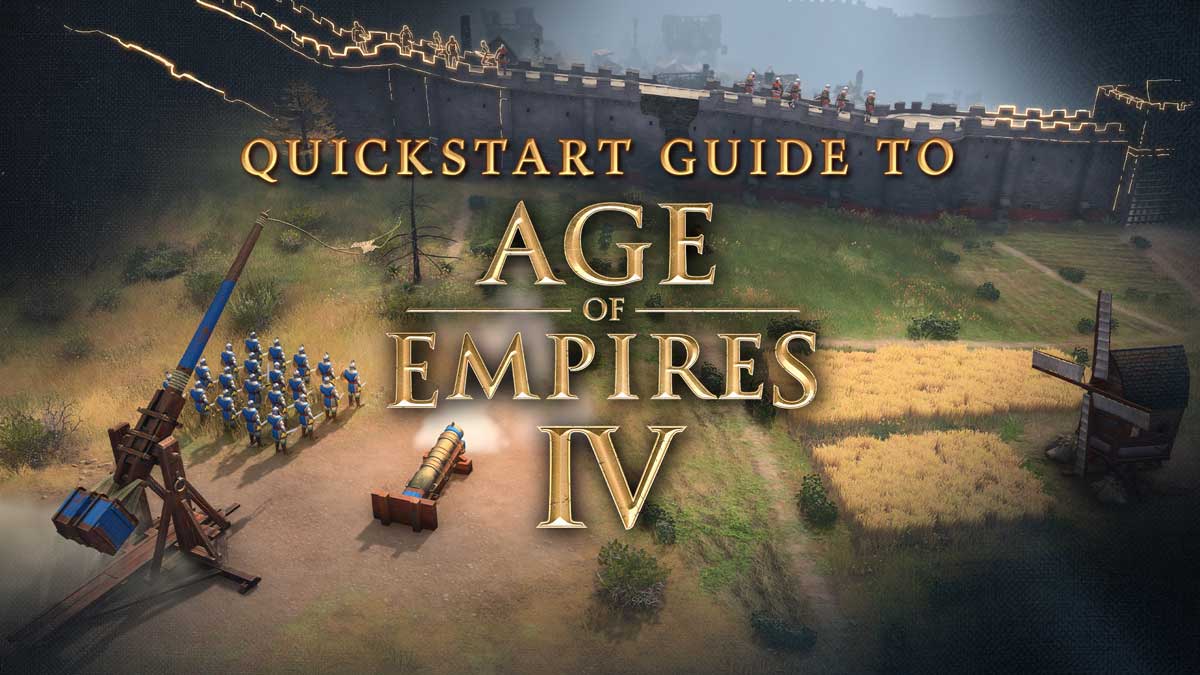Age of Empires IV: Face To Face With History

Xbox Game Studios
Originally, the focus was on the progression of the first civilizations from the Stone Age to the Iron Age, to then move on to the numerous war facets of the Middle Ages, up to the European colonization of the Americas. Three historical macro-contexts wisely used by Ensemble Studios to create those three chapters of the Age of Empires saga which – between 1997 and 2005 – gathered under the banner of Microsoft an incredibly large crowd of fans of real-time strategy.
A triptych of productions that have remained in the hearts of gamers that in recent years the colossus of the Redmond house has brought back into vogue through the remastered made by the collaboration of Forgotten Empires and Tantalus Media, reinvigorating the technical sector and beyond.
The Definitive Editions of the first, second and third chapters had the clear objective of preparing the market for the publication of Age of Empires IV, stimulating the interest of an important slice of users, mainly newbies, reachable thanks to the Xbox Game Pass phenomenon. . Obviously without forgetting the long-standing historical gamers who have grinded hours and hours on their old assemblies.
After a long wait, we finally got our hands on a Steam code of the new fourth chapter by delving into the vision of the talented guys of Relic Entertainment, carefully chosen by Microsoft to hold the reins of this incredible project. Does Age of Empires IV manage, in short, to keep its head high in front of its predecessors and an extremely demanding audience like that coming from the world of RTS?
The answer, we anticipate, is absolutely positive, but with some due considerations resulting from small compromises necessary to make everyone agree.
Back to the past
That Age of Empires IV should have collected the heavy legacy left above all by the second chapter can be seen from the choice of the same historical period, with the revival of that Middle Ages theatre of countless battles as well as the birth or fall of kingdoms and dynasties all over the world.
The latest work by the Canadian team tries, on the one hand, to remain strongly anchored to the RTS tradition, while on the other it offers small variations that modernize the gameplay to make it more appealing to newbies.
A choice that can be seen from the moment you enter the game menu where – in addition to the re-presentation of the unmistakable soundtrack that made the brand great – we find a clearer and more streamlined interface, divided into well-defined compartments that helps you decide whether to try your hand in the single player experience, between campaigns and offline skirmishes, or in online matches against other real players.
All this, introducing a renewed section that keeps track of the player’s progress through small daily challenges, experience points; a hint of a progression system that implies the desire to stimulate playing Age of Empires IV constantly over time, trying every facet of it.
Focusing in the first instance on the four campaigns available on day-one for as many factions, compared to the eight presents, we want to reassure you of the commitment made by the development team to obtain a result qualitatively up to expectations.
If for Age of Empires II a certain balance had been found between academic and fictional historical tale – through direct dialogues of the various main heroes impersonated – and in Age of Empires III the path of the more narrative story had been tried, with this fourth chapter we opt for a road totally focused on a much more academic and refined chronicle, the result of a timely exhibition aimed at discovering the customs and traditions of the impersonated faction.
In fact, completing the missions of the various campaigns of Age of Empires IV allows you to unlock small documentaries – just like the one that became famous on the use of the trebuchet – involving experts and footage worthy of the good times of the History Channel.
Did you know that the typical trot of Mongolian horses was a distinctive trait useful for keeping fatigue to a minimum and allowing the warriors to rest in the saddle without too many problems? And that the chain mail of the armor had numerous metal coatings that sacrificed lateral mobility? Or that the crossbows had a leather strap at the end that is useful for applying pressure with the foot and better tensioning the rope? These and other interesting notions are discovered with the passing of the hours and can only delight both the most passionate about history and the simple curious.
Contentistically, as regards the playable campaigns, we are talking about a total of over 30 missions, divided between the Norman invasion of England from 1066, the subsequent Hundred Years War, the Mongol horde of Genghis Khan and the birth of the Rusian superpower. All this takes place through about five centuries of history, with a succession of extremely varied objectives while maintaining a fairly classic formula for the genre.
We found ourselves reliving sieges of vast proportions, focusing on growing more settlements by gathering specific resources, or creating targeted ambushes by sipping troops, often managing some secondary and optional objectives – and having fun time and time again.
This is mainly thanks to an enemy AI already at normal difficulty capable of putting a spoke in the wheel. Completing each mission will take from 20 to 40 minutes, depending on the chosen difficulty, and considering the value of the proposed stories we hope to see as soon as possible the campaigns linked to the remaining factions and equally thick.
There is also a section called “The art of war”, used as a tutorial through targeted objectives for novices, useful for becoming familiar with the various game mechanics, also waiting on this front to see new challenges such as historical battles or pre- set, to encourage the return of users already in the short-medium term.
The risk of getting bored after completing the four campaigns remains and should be reduced as much as possible, and the mod support promised for 2022 can be a great way to avoid it.
Control your army with one click
As anticipated, the gameplay of Age of Empires IV does not differ much from its origins and reconfirms all those mechanics typical of good RTS with small and intriguing improvements. A largely shared choice, useful for weighing some uncertainties on a quantitative level that could turn up their noses a bit at all those accustomed to the sea of content available in the Definitive Edition of Age of Empires II.
Based on the return of the classic skirmish, we start with a small town and a handful of commoners to collect resources – classic gold, wood, stone and food – to advance through the four available eras and have the possibility of obtaining more and more buildings and units strong.
The balance between micro-management of one’s own settlement and guiding troops on the battlefield is what has always distinguished the reference brand over the years, and could only be a fundamental node of Age of Empires IV. The focus of the Relic Entertainment project is to obtain an immediate approach, capable of rewarding the most attentive players to every minutia without forgetting to entertain those who prefer to play it for pure entertainment and with the brain off.
It should also be highlighted a leaner and cleaner game interface that does not sacrifice the amount of information to keep an eye on – where we particularly appreciate the choice of keeping track of the number of inhabitants dedicated to the collection of a specific resource or a ‘ other, in addition to the classic report of the common people who are not doing anything and awaiting some new order.
Speaking of the eight civilizations present on day one, these are fairly varied factions both in terms of buildings, characterized by different bonuses depending on the origin, and of the units, with a handful of special troops depending on the case – such as the English longbows , the archers on horseback of the Mongols or the camels of the Lower Dynasty.
A choice that, at least in part, compensates for a not great summary quantity of ground troops, relegated to a handful of generic references for each rather sparse category such as pikemen, swordsmen, archers and crossbowmen, in addition to cavalry. The naval units are also returning and under this juncture we have a more marked variety, allowing you to create varied fleets capable of giving every enemy a hard time.
Instead, we appreciated even more the range of possibilities linked to defensive constructions, through outposts and towers that can be upgraded in several ways, and with the stone walls finally passable by shooting units to have a greater range on the attackers; situations that during the clashes translate into a greater spectacularization of the sieges between catapults, archers and soldiers who try to exploit some tower to invade enemy positions, always net of a bit of confusion that is created when the most armies are deployed. numerous.
Good work also on the front of the balance of the various units of Age of Empires IV, where finally we do not have lethal catapults for the troops or monks too effective in healing, while in the online games we worry about the excessive use of horse archers for their dexterity and boundless speed that can create a bit of frustration.
Excluding the special units mentioned, or a peculiar aesthetic aspect of the buildings that reflects the origin of the selected civilization, choosing one faction over another allows you to vary the approach to the games, regardless of whether they are offline skirmishes or against other real players .
The Abbasid Dynasty, for example, refers to greater technological bonuses that improve damage and resistance of units if wisely developed, the Mongols can move their buildings constantly in search of resources by exploiting the more nomadic nature, while the Chinese have on their side the use of gunpowder for the first rifles and cannons; it will be impossible not to have a favorite faction, through a scheme that differentiates the games with a certain unpredictability according to the many possible combinations.
The life of the castle
Technically speaking, the work done by the guys at Relic Entertainment convinces on several fronts. Age of Empires IV makes an incredible graphical leap forward compared to its predecessors, and it is denoted in the level of textures of the various buildings, in the details of various armor, or in the animations used for the buildings.
The access requirements are all in all permissive – we are talking about a type of game where a more modern combination of processor and motherboard is enhanced, rather than the mere graphics card – and with our updated configuration between RTX 3070 and tenth generation i7 processor we kept all the details to the maximum with the 4K active and a frame rate anchored to 60 fps without excessive problems, except during some more numerous clashes.
The rendering of the game maps between level vegetation and fauna is excellent, while for the gold and stone resources it is inexplicable to have paid less attention to the level of polygonal density, if we really have to be meticulous.
There are also some problems related to pathfinding, which can be found when selecting more numerous armies to cross bridges, bottlenecks or mountain passes, even engaging in battle with some well-positioned enemy.
Finally, the stability of the online servers is good, where you can search for matches ranging from 1vs1 to 4vs4 or cooperate against AI, in a rather classic range of possibilities and which reflects what emerges from the limited options available for offline skirmishing.
Age of Empires IV rating
Age of Empires IV is the natural evolution – albeit with some limitations – of that second chapter released in 1999 and still impressed in the minds of many fans. A product packaged with some improvements that make it more modern and captivating, suitable for the simple curious addicted to Xbox Game Pass on PC, which maintains a keen awareness of the work originally done by Ensemble Studios. If we think that the success of the second chapter is to be found in the incredible support given over time with the various expansions, the foundations for directing the fourth chapter on the same path are all there.
PROS
- Fun campaigns set up like interactive documentaries
- The civilizations available are well differentiated, especially in the micro management of settlements
- Finally, the sieges begin to be more multifaceted
- Technically solid and beautiful to look at
CONS
- We would have preferred more ground troop options, both special and standard
- The chaos of the battles remains a constant with the larger armies, discouraging players who prefer a more reasoned assault
- Some problems related to pathfinding







